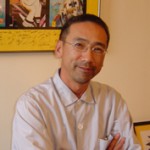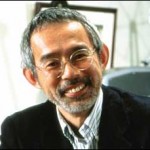Ask John: Who Have Been the Most Influential People in America’s Anime Industry?
Question:
Who have been the most influential people in the anime industry over the past 20 years?
Answer:
I hope it’s obvious that this question affords the possibility of a book length answer. At my present state, I have neither the knowledge nor motivation to compose such a thorough dispatch, so my answer will be brief and may very well criminally exclude names that I’ve simply not thought to mention. Furthermore, as a consequence of my limited knowledge, I’ll have to cite both individuals and organizations in the event I’m not aware who the precise individual deserving credit is. Finally, this is my own, subjective observation, drawn as someone involved in America’s anime industry but not a primary “industry insider.” I’m also going to take the “past 20 years” time frame a little bit liberally by starting from the mid 1980s rather than strictly 1989.

Love him or hate him, Carl Macek must be credited with practically launching the American commercial anime distribution industry. Although he wasn’t the first person to bring anime to America, Mr. Macek was the first American businessman to emphasize the Japanese origin of anime and its distinctive differences from homegrown American animation. Macek will always be most remembered for creating Robotech, the popular Frankenstein’s monster hybrid of three unrelated anime series. However, Macek was also instrumental in bringing anime including Akira, Vampire Hunter D, Robot Carnival, Dirty Pair, Lupin III, Captain Harlock, Fist of the North Star, and numerous other titles to America.

Seiji Horibuchi founded Viz Communications in 1986 and published the company’s first English translated manga the following year. Viz wasn’t the first publisher to release translated manga in America, but Viz was the first publisher to concentrate on introducing America to the phenomenon of Japanese comics. Rather than release just one title, Viz was the first publisher to translate and distribute a variety of manga titles representing an range of genres.
Manga translator and critic Toren Smith‘s contribution to the American anime industry may be largely forgotten today, but its impact is more prevalent now than ever. Mr. Smith should be credited as America’s pioneering champion for responsible, accurate, and authentic translation. From the 1960s through the mid 1980s, Japanese pop art brought to America was typically heavily altered for American consumption. Toren Smith insisted upon English translation that remained faithful to the intentions of its Japanese creators. The fact that an expectation for translation accuracy is taken for granted today is largely due to Mr. Smith’s influence on the fan community and manga publishing industry during the 1990s.
Anime scholars Fred Schott and Fred Patton are responsible for convincing Americans that anime and manga are a serious and legitimate art form. Their books and writing acknowledged anime and manga as a cultural, historical, and literary invention, not as merely a cheap, disposable commodity. Their influence has affected the perception of generations of American anime fans.
Robert Napton & David Keith Riddick were instrumental in the formation of US Renditions, Books Nippan’s home video distribution branch. US Rendition’s March 1990 releases of Gunbuster and Dangaioh marked the first ever subtitled anime released on American commercial home video.

The heads of any and every American anime distribution house deserve some acknowledgment for their contributions to the American anime industry, but Central Park Media founder John O’Donnell deserves extra recognition for two reasons. In 1996 O’Donnell commissioned M.D. Geist creator Koichi Ohata to create a sequel, as much for the American market as for Japan. American companies contracting Japanese studios to produce animation was nothing new by 1996, but an American company financing the production of an original anime – not an American created cartoon animated overseas – established the precedent for later co-productions like Ghost in the Shell, The Big O, and Afro Samurai. Furthermore, Central Park Media, under Mr. O’Donnell, gave America its first anime DVD: director Masami Obari’s Battle Arena Toshinden OVA series.
Children’s television program producer DiC Entertainment isn’t commonly considered a significant player in the anime industry, but DiC USA chairman Andy Heyward should be given credit for introducing Americans to modern shoujo anime. Princess Knight got very limited American television exposure in the late 1970s, but it was DiC’s 1995 broadcast of Sailor Moon that introduced shoujo anime to all of America.
![]()
The Cartoon Network’s Toonami program, visibly represented by producer Sean Akins, aired Voltron in 1997, and launched Robotech, Sailor Moon, and Dragon Ball Z in 1998. While DiC introduced America to shoujo anime, Toonami put anime into every American household. Networks including Nickelodeon, UPN, and even the Sci-Fi Channel broadcast anime prior to Toonami, but Toonami was the first network to group anime and promote its stylish chic. Toonami convinced America that watching anime was cool.

The Anime on DVD website, now an integrated part of the larger Mania.com site exerted an influence that irrevocably forced the evolution of the American anime industry. Webmaster Chris Beveridge and fellow reviewers and site visitors introduced a consumer demand for quality that had never existed prior to the DVD era. Mr. Beveridge inspired expectations for excellent image & sound quality, supplemental material, and attractive packaging – consumer demands that were never seriously considered in the VHS distribution era. The Anime on DVD website practically single-handedly forced America’s commercial anime distribution industry to establish and live up to high standards. Anime on DVD turned consumers into critical consumers.

Viz Media pioneered manga distribution in America. Tokyopop, under the advisory of Stuart Levy, revolutionized it. Tokyopop wasn’t America’s first publisher to release manga in “unflipped” Japanese right-to-left format, but Tokyopop’s “100% Authentic” promotion brought awareness to the publishing decision and set the precedent that the entire American publishing industry now follows. Furthermore, Tokyopop standardized the publishing size and retail price of domestic manga graphic novels. All domestic manga publishers now either adhere to the standard Tokyopop established or diverge from it.

In 1997, following the signing of Tokuma Shoten’s distribution agreement with the Walt Disney company, Miramax was put in charge of preparing the anime film Princess Mononoke for American theatrical release. Studio Ghibli producer Toshio Suzuki sent a samurai sword and the simple message, “No cuts,” to Miramax executive Harvey Weinstein. This concise statement still rings as a resonant reminder that America’s anime industry has a responsibility to profitably distribute anime while respecting the work that its Japanese creators put into it.
When Mike Tatsugawa founded the Society for the Promotion of Japanese Animation (SPJA) in 1991 I doubt he foresaw that the anime convention the SPJA organizes, Anime Expo, would eventually become the de facto American anime industry trade show that brought the executives of America’s anime industry together face-to-face every year. Simultaneously, and ostensibly, Anime Expo is America’s largest anime fan convention and the American anime industry’s foremost opportunity to market to and interact with its customers, supporters, and detractors.
No one seems to remember exactly what the first digital fansubbing group was, but suspicion centers around Animefactory‘s August 14th, 2000 release of Megami Kouhosei episode 00. Although digital fansubbing didn’t start out as part of the American anime distribution industry, its impact on the industry worldwide has been immeasurable. In the VHS era, an anime was “new” if it reached America within a year of its Japanese release. The first episode of Candidate for Goddess reached America, unofficially translated in English, eight months after its Japanese premiere. From that beginning, we now have officially translated and distributed anime episodes reaching American viewers a mere hour after Japanese broadcast.

Pixar Chief Creative Officer John Lasseter was instrumental in bringing Studio Ghibli’s 2001 feature Spirited Away to America. Lasseter served as executive producer for the American localization, and has since been an outspoken proponent of anime creator Hayao Miyazaki. Spirited Away took the 2002 Oscar for Best Animated Film, and it’s both that recognition and Lasseter’s enthusiasm for Miyazaki’s animation that have helped propel anime into mainstream American recognition and grudging respect.

Crunchyroll founders Kun Gao, Vu Nguyen, Brandon Ooi, and James Lin launched Crunchyroll in 2006, initially streaming unlicensed anime fansubs and Asian movies. The site quickly grew in size and prominence until now, three years later, it’s one of America’s foremost officially authorized anime distribution companies. Crunchyroll has negotiated unprecedented partnerships with Japanese distribution companies, resulting in a greater amount of anime reaching America faster than any other domestic distributor has ever approached. Crunchyroll has also been accused of significantly contributing to the practical extinction of the traditional American anime specialty distribution industry.
Add a Comment
You must be logged in to post a comment.


Gosh, John Lasseter looks like Tony Soprano!
Surprised you mentioned Toren, given that he’s burned a lot of bridges over the years in his recent rants. I actually like that aspect of him, even though I think global warming is real, but a lot of people were up in his face for trashing Tokyopop’s manga model. I don’t like to give DiC[k] too much credit, though, since, even though it took a chance on shojo anime, it sat on the license for a long time without actually doing anything with it, just to charge a ransom for the rights to the uncut versions. I’d also complain about the company trying to come up with a live-action version of SM, but Toei actually went for it, so…
As for AOD, um, I actually think they’ve been counter-productive to the industry as a whole, since their anal-retentive obsession with quality combined with import-savvy fans who buy the same moe crap as Japanese otaku has probably put a lot of domestic licensors out of business, due to a lack of actual market demand for certain titles. Plus, a DVD which is passable to the casual viewer ends up being panned and/or “boycotted” by those stingy f**ks for not meeting whatever imaginary “seal of approval” they can come up with for that particular moment. There are R1 dvds which companies get wrong, [*cough* Blood+, everything handled by Toei, *cough*] but when you’re more concerned with a pencil board than you are with the show, then you’re not exactly doing anything for the rest of us who just want to watch.
“In 1997, following the signing of Tokuma Shoten’s distribution agreement with the Walt Disney company, Miramax was put in charge of preparing the anime film Princess Mononoke for American theatrical release. Studio Ghibli producer Toshio Suzuki sent a samurai sword and the simple message, “No cuts,†to Miramax executive Harvey Weinstein.”
Then Miyazaki said it was ok to cut Spirited Away. =p Actually, I can’t verify if it’s true, but someone pulled a quote on me from a year earlier in which he said he’d never do business with Disney. Anyway, Harvey still got his revenge by sabotaging the movie’s distribution. Or maybe it wasn’t revenge as much as an extension of his hatred of all films made by Asians.
“This concise statement still rings as a resonant reminder that America’s anime industry has a responsibility to profitably distribute anime while respecting the work that its Japanese creators put into it.”
Unless the distributors cut out songs because they’re too cheap to pay record companies. Then they’re still better than ADV. =p On a related note, why is Macek on there, but not DLW and Woodhead?
“Pixar Chief Creative Officer John Lasseter was instrumental in bringing Studio Ghibli’s 2001 feature Spirited Away to America. Lasseter served as executive producer for the American localization, and has since been an outspoken proponent of anime creator Hayao Miyazaki. Spirited Away took the 2002 Oscar for Best Animated Film, and it’s both that recognition and Lasseter’s enthusiasm for Miyazaki’s animation that have helped propel anime into mainstream American recognition and grudging respect.”
I think Lasseter’s man-crush for Miyazaki is admirable, but I wish he’d do more for the 2-d medium than endorse straight-to-video sequels of Disney classics. And frankly, I thought how his “marketing push” for Spirited Away
was almost as shoddy as that of Miramaxe’s “support” for Princess Mononoke. It does well in limited, and even makes more money than Pokemon 4ever, and what do they do with Spirited Away? Reduce the number of theaters for it, anyway. And the advertising revenue ends up going for a Miyazaki rip-off like Treasure Planet. Plus, for a guy who actively supported Miyazaki, he took an awfully long time to get his older stuff on DVD, considering that the minute that Cagliostro and Princess Mononoke hit R1, they sold like hot-cakes. And I imagine if Spirited Away didn’t win an Oscar, Lasseter would still try to take credit for “believing” in Miyazaki, while continuing to look the other way on BV stalling on the R1 DVD for SA. Seriously, for a company which pretends to love the guy, I’ve never seen such contempt for the handling of his work in the U.S. up until 2003. Could http://www.brightlightsfilm.com/65/65up.html be the reason? ^_-
“Crunchyroll has also been accused of significantly contributing to the practical extinction of the traditional American anime specialty distribution industry.”
Total bullshit, too. Many of the shows on that site weren’t even being torrented by the majority of fans. If anything, CR’s doing a favor for the rest of us who want to choose a title based on its individual appeal, and not based on the group-think of the geeks who don’t know shit about what’s cool.
John, I think you more than have enough knowledge to fill a book about the subject, and I think a History of the American Anime Industry is long overdue. Anime is such a fast-evolving media here because its audience is generally on the cutting edge of consumer tech that it’s amazing to think how things have changed so much in just five years and all of the people who have contributed to the industrry. I’d definitely pick a copy!
On the Crunchyroll comment, I grudgingly admit they are on a front runner in the new anime distribution paradigm, but I can’t stand how they got there by stealing anime and then more or less forcing anime companies to use their service because it was the most popular. It’s like Best Buy selling their wares to a ring of shoplifters who a low price because they’ll just steal it anyway and resell it cheaper, so they might as well get some money out of it.But I’m an otaku dinosaur who still insists on collecting official DVD releases, so what do I know? I’m just not going to give them a red cent, personally, but I concede they are the direction things seem to be going.
I do admit that it may seem like an obvious omission not to mention Matt Greenfield, John Ledford, David L. Williams, or industry vets like Robert Woodhead, but that’s why I said, “The heads of any and every American anime distribution house deserve some acknowledgment.” There’s a difference between being America’s most successful and America’s most influential. Ledford and Greenfield certainly helped build (then destroy) one of America’s powerhouse distributors, but I question how much they revolutionized the industry. I love Robert Woodhead for maintaining his integrity, but AnimEigo was not the first American subbed anime distributor, nor was it America’s most successful or influential.
Great list; I hope fans new to the medium do a bit of research and become familiar with these names and the many projects they influenced over the years.
Kudos for mentioning the Freds, they’re my personal favorites by a long shot. Schodt’s THE ASTRO BOY ESSAYS is the most comprehensive biography of Tezuka in English to date (in addition to including a whole lot more between its covers), and Patten’s WATCHING ANIME/READING MANGA collection of articles is, quite literally, one of my bible’s of anime literature.
“There’s a difference between being America’s most successful and America’s most influential.”
Considering Whedon wouldn’t have a career without Yohko, er, Buffy, I’d say that’s pretty influential. ^_- All kidding aside, the ADV people were both successful and influential.
“Ledford and Greenfield certainly helped build (then destroy) one of America’s powerhouse distributors, but I question how much they revolutionized the industry.”
Last time I checked, Sojitz destroyed the company. As for their influence, they came up with those thin-packs which saved the rest of the industry from dying from the old singles-only model. The company also helped pave the way for a market for more middle-ground anime titles which didn’t simply appeal to import-savvy geeks, art-house lovers, and children. Plus, they took the Toonami thing to the next level with an actual cable channel devoted to anime, and not just a slot which showcased some anime. And their manga line-up made it possible for more artsy titles like Yotsuba to be profitable.
“I love Robert Woodhead for maintaining his integrity, but AnimEigo was not the first American subbed anime distributor, nor was it America’s most successful or influential.”
It was the first company to create a standard of purity and quality for subs, and the first company to place an emphasis on liner notes, though.
Actually, when I created Anime Expo, I knew it could become what it has become today. However, I didn’t trust the industry to control or manage it because they would just use it as a marketing tool for themselves. We learned our lessons the hard way during AnimeCon 91. This is why Anime Expo was created as a 501(c)6 Trade Association but with none of the voting seats given to any leaders in the industry. It was the fact that the companies had to compete year over year to be the dominant company at the convention each year that it became such a great place for fans to go get the full anime experience.
Mike